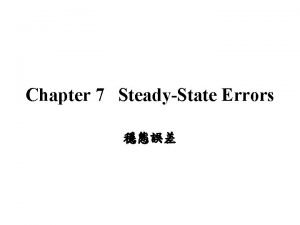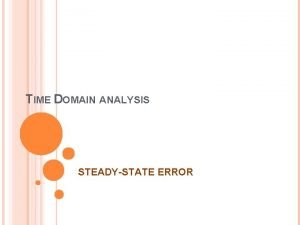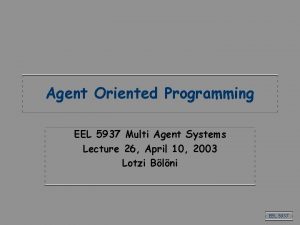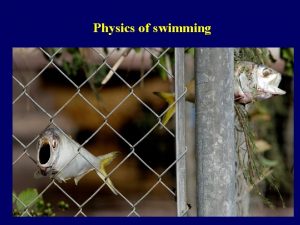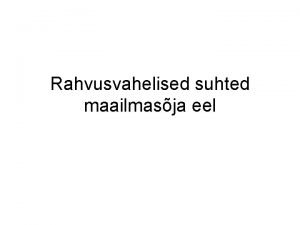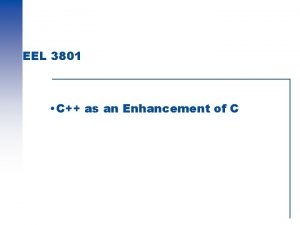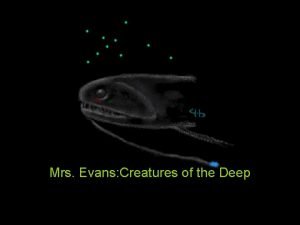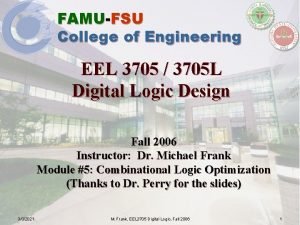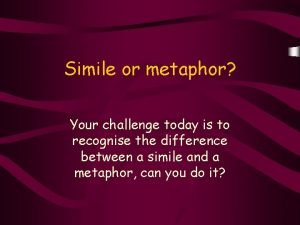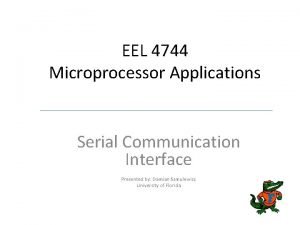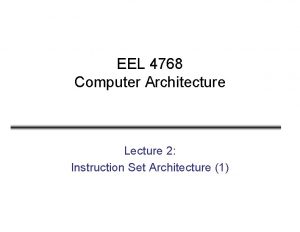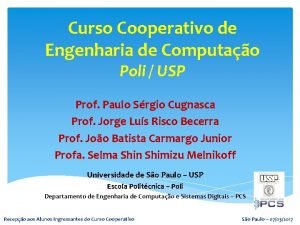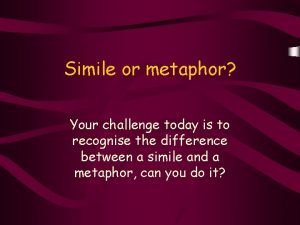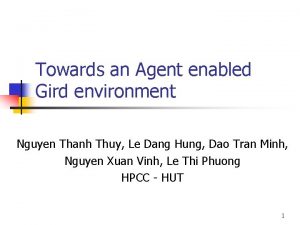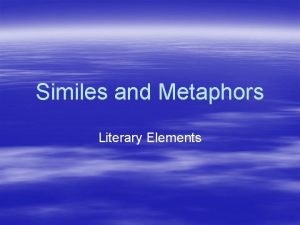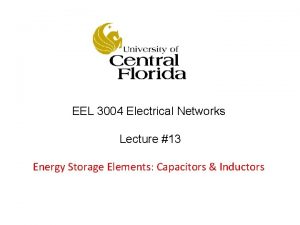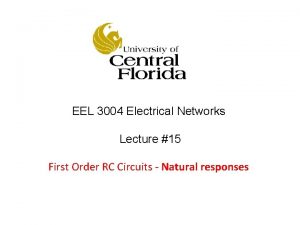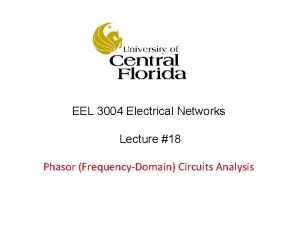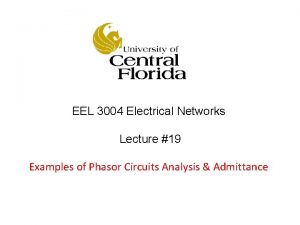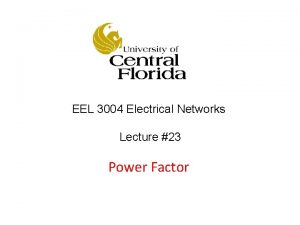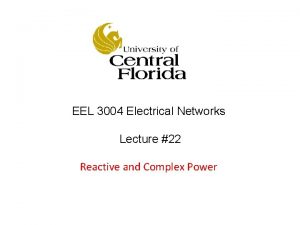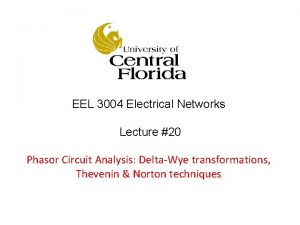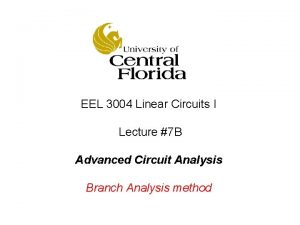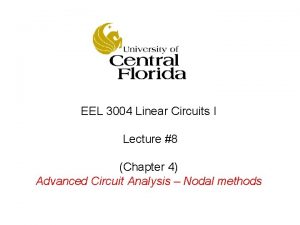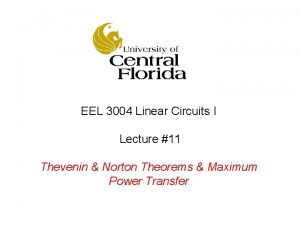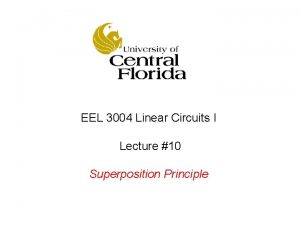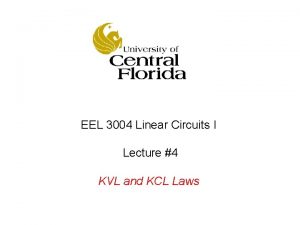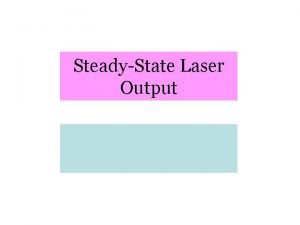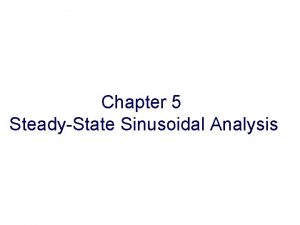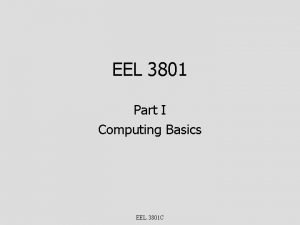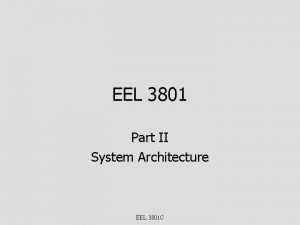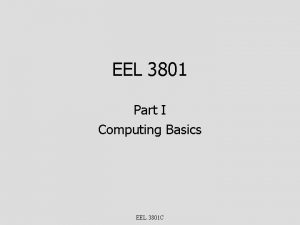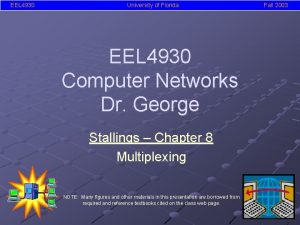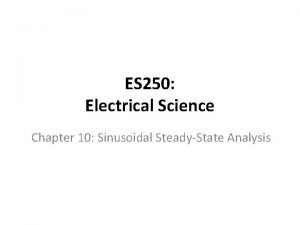EEL 3004 Electrical Networks Lecture 14 SteadyState DC


























- Slides: 26

EEL 3004 Electrical Networks Lecture #14 Steady-State (DC) RLC Circuits

Lecture Objectives The lecture today will focus on: Ø Introduction to steady-state (DC) analysis of RLC Circuits Ø Circuits with only DC sources & without switches. Ø Examples

RECALL Capacitor Observations • Like the resistor, the capacitor exhibits an algebraic relationship between its branch voltage and the stored charge on its plate. • Time varying voltage applied across the capacitor will induce current flow in the capacitor caused by charge variations through the charging process. • Constant voltage (DC) applied across the capacitor will result in zero capacitor current. • If the voltage across the capacitor changes its value instantly i. e. dt=0, then an infinite current is required. hence,

RECALL Inductor Observations • Like the resistor, the inductor exhibits an algebraic relationship between its terminal current and the induced magnetic flux in the core. • When time varying current is applied across the inductor, it induces voltage across the inductor winding caused by magnetic field variation. • When the inductor current is a fixed DC value, there is no voltage induced across it. • If the inductor current changes its value instantly i. e. dt=0, then the resultant induced voltage will be infinity. hence,

RLC circuits with DC sources and NO Switching (Steady-state) If the circuit consists only of direct current and voltage sources (dc), then the capacitor behaves as an open circuit, and the inductor behaves as a short circuit. Under DC conditions – the circuit has been undisturbed for a long time

Example Under DC conditions, find: a) The current passing through the inductor, b) The energy stored in the inductor Variable Values Unit VDC 2 V IDC 20 m. A R 1 1. 2 kΩ R 2 1. 6 kΩ R 3 2. 4 kΩ R 4 3. 4 kΩ L 56 m. H

The voltage across the inductor is considered zero under dc conditions:

The voltage across the inductor is considered zero under dc conditions: Simplifying the circuit yields

Where Req is given by:

Where Req is given by: Applying KCL at node V 1 yields:

Where Req is given by: Applying KCL at node V 1 yields: Solving for V 1 yields:

Now IL can be calculated by voltage division:

Now IL can be calculated by voltage division: The energy stored in the inductor is given by:

Example For the RLC circuit under DC conditions, find: a) The inductor currents and capacitor voltages, b) The energy stored in each inductor and capacitor. Variable Values Unit V 8. 6 V I 4. 6 m. A R 1 1. 2 kΩ R 2 1. 6 kΩ R 3 2. 4 kΩ L 1 120 m. H L 2 360 m. H L 3 320 m. H C 1 240 F C 2 340 F

The inductor acts as a short circuit, the capacitor like an open circuit under dc conditions:

The energy stored in the inductors is given by:

The energy stored in the capacitors is given by:

Example a) Design the load resistor RL so that in steady-state the energy stored in the capacitor and inductor are equal. b) Find the voltage VL. c) Find the power dissipated in RL. Variable Values Unit VS 6 V R 200 Ω L 250 m. H C 25 F

In steady state, the circuit becomes: The current in the inductor is given by:

In steady state, the circuit becomes: The current in the inductor is given by: Energy stored in the inductor is given by:

In steady state, the circuit becomes: The current in the inductor is given by: Energy stored in the inductor is given by: The voltage in the capacitor is given by:

In steady state, the circuit becomes: The current in the inductor is given by: The voltage in the capacitor is given by: Energy stored in the inductor is given by: Energy stored in the capacitor is given by:

In steady state, the circuit becomes: Equalizing the energy stored yields:

In steady state, the circuit becomes: Equalizing the energy stored yields: Solving for the load resistance:

In steady state, the circuit becomes: The voltage VL is easily found as:

In steady state, the circuit becomes: The voltage VL is easily found as: The power dissipated in RL is given by:
 Steady-state error
Steady-state error In time domain analysis, finite steady state error is
In time domain analysis, finite steady state error is Ucf psychology major
Ucf psychology major Namas chandra
Namas chandra 01:640:244 lecture notes - lecture 15: plat, idah, farad
01:640:244 lecture notes - lecture 15: plat, idah, farad Datagram switching vs virtual circuit
Datagram switching vs virtual circuit Basestore iptv
Basestore iptv Eel programming language
Eel programming language Gulper eel habitat
Gulper eel habitat Eel locomotion
Eel locomotion Rahvusvahelised suhted
Rahvusvahelised suhted Sentence variety
Sentence variety C++ eel
C++ eel Gulper eel food
Gulper eel food Eel 4768
Eel 4768 Eel 3705
Eel 3705 Escola de engenharia de lorena
Escola de engenharia de lorena Challenge metaphor
Challenge metaphor Eel4744
Eel4744 Eel 4768
Eel 4768 Deep sea hatchetfish adaptations
Deep sea hatchetfish adaptations Estagios poli usp
Estagios poli usp Eel 4712
Eel 4712 The woman in black summary
The woman in black summary Simile challenge
Simile challenge Nguyen
Nguyen Whats a simile
Whats a simile
